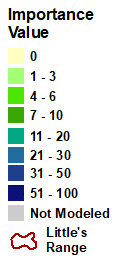American hornbeam; musclewood (Carpinus caroliniana)
Model Reliability: Low
| GCM SCENARIO | % Area Occ | Ave IV | Sum IV | Future/Current IV |
|---|---|---|---|---|
| Actual | 13.7 | 2.3 | 9395 | N/A |
| RFimp | 14.3 | 1.5 | 6302 | 0.67 |
| CCSM45 | 34.2 | 1.5 | 15089 | 2.39 |
| CCSM85 | 43.8 | 1.7 | 21556 | 3.42 |
| GFDL45 | 43.4 | 1.6 | 20064 | 3.18 |
| GFDL85 | 57.8 | 1.6 | 26451 | 4.2 |
| HAD45 | 40.1 | 1.6 | 18586 | 2.95 |
| HAD85 | 50.2 | 1.5 | 21496 | 3.41 |
| GCM45 | 45.8 | 1.3 | 17913 | 2.84 |
| GCM85 | 60 | 1.3 | 23168 | 3.68 |
Regional Summary Tree Tables
Summaries for tree species are available for a variety of geographies, in both PDF and Excel format. These summaries are based on Version 4 of the Climate Change Tree Atlas
Interpretation Guide
American hornbeam, or musclewood, is a widely distributed (10.7% of area), sparse, low IV but common species distributed widely across the eastern US. It is modeled as a large increaser (RCP 8.5) or small increaser (RCP 4.5) with a low reliable model, but because of its medium adaptability and increasing status, its overall rating is very good (RCP 8.5) to good (RCP 4.5). SHIFT shows that this is a good infill species with some migration capability.
Family: Betulaceae
Guild: persistent, slow-growing understory tolerant
Functional Lifeform: small deciduous tree
| 5.1 | 0.56 |
| 0.62 |  |
MODFACs
What traits will impact American hornbeam; musclewood's ability to adapt to climate change, and in what way?:
Primary Positive Traits
Shade tolerance Seedling establishment
Primary Negative Traits
Fire topkill Drought



